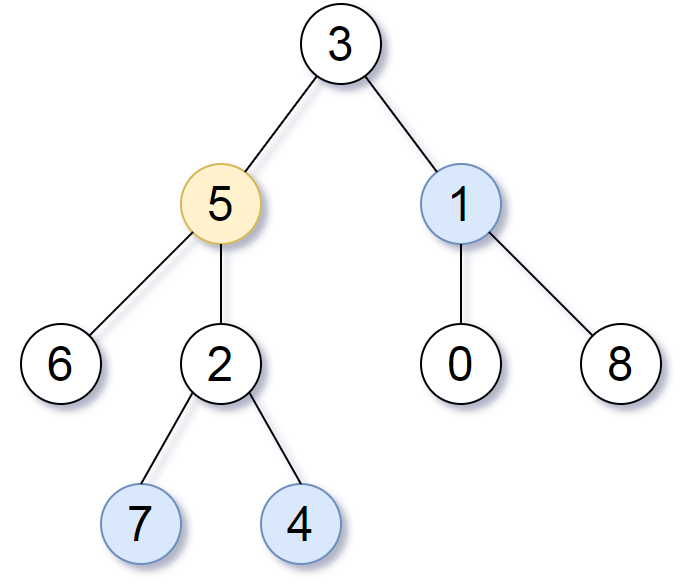We are given a binary tree (with root node root), a target node, and an integer value K.
Return a list of the values of all nodes that have a distance K from the target node. The answer can be returned in any order.
Example 1:
Input: root = [3,5,1,6,2,0,8,null,null,7,4], target = 5, K = 2
Output: [7,4,1]
Explanation:
The nodes that are a distance 2 from the target node (with value 5)
have values 7, 4, and 1.
 Note that the inputs "root" and "target" are actually TreeNodes.
The descriptions of the inputs above are just serializations of these objects.
Note that the inputs "root" and "target" are actually TreeNodes.
The descriptions of the inputs above are just serializations of these objects.
Note:
- The given tree is non-empty.
- Each node in the tree has unique values
0 <= node.val <= 500.
- The
target node is a node in the tree.
0 <= K <= 1000.
root), a target node, and an integer value K.K from the target node. The answer can be returned in any order.
Example 1:
Input: root = [3,5,1,6,2,0,8,null,null,7,4], target = 5, K = 2 Output: [7,4,1] Explanation: The nodes that are a distance 2 from the target node (with value 5) have values 7, 4, and 1.Note that the inputs "root" and "target" are actually TreeNodes. The descriptions of the inputs above are just serializations of these objects.
Note:
- The given tree is non-empty.
- Each node in the tree has unique values
0 <= node.val <= 500. - The
targetnode is a node in the tree. 0 <= K <= 1000.
Approach 1: Annotate Parent
Intuition
If we know the parent of every node
x, we know all nodes that are distance 1 from x. We can then perform a breadth first search from the target node to find the answer.
Algorithm
We first do a depth first search where we annotate every node with information about it's parent.
After, we do a breadth first search to find all nodes a distance
K from the target.
Complexity Analysis
- Time Complexity: , where is the number of nodes in the given tree.
- Space Complexity: .
Approach 2: Percolate Distance
Intuition
From
root, say the target node is at depth 3 in the left branch. It means that any nodes that are distance K - 3 in the right branch should be added to the answer.
Algorithm
Traverse every
node with a depth first search dfs. We'll add all nodes x to the answer such that node is the node on the path from x to target that is closest to the root.
To help us,
dfs(node) will return the distance from node to the target. Then, there are 4 cases:- If
node == target, then we should add nodes that are distanceKin the subtree rooted attarget. - If
targetis in the left branch ofnode, say at distanceL+1, then we should look for nodes that are distanceK - L - 1in the right branch. - If
targetis in the right branch ofnode, the algorithm proceeds similarly. - If
targetisn't in either branch ofnode, then we stop.
In the above algorithm, we make use of the auxillary function
subtree_add(node, dist)which adds the nodes in the subtree rooted at node that are distance K - dist from the given node.
Complexity Analysis
- Time Complexity: , where is the number of nodes in the given tree.
- Space Complexity: .
No comments:
Post a Comment